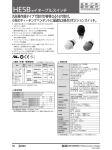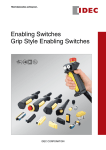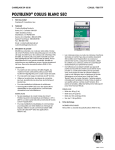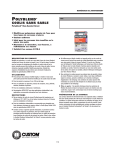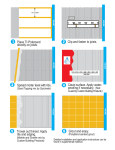Download Type HE5B ENABLING SWITCH Operating Instructions
Transcript
Type HE5B ENABLING SWITCH Operating Instructions Use the ENABLING SWITCH according to the following instructions after confirming that the product is what you have ordered. Safety Precautions ! ・Read this instruction sheet to make sure of correct operation before starting installation, wiring, operation, maintenance, and inspection. Also, keep this instruction sheet at the end user. ・Turn off the power to the enabling switch before starting installation, wiring, maintenance, and inspection of the enabling switch. Failure to turn power off may cause electrical shocks or fire hazard. ・Use wires of proper size to meet voltage and current requirements. Using improper wires may cause fire hazard due to abnormal heat generation. (1) Application The enabling switch permits machine operation only while the enabling switch is manually operated for robot teaching or other purposes in hazardous areas. Make sure that the control system is designed to activate the machine only when the enabling switch is at position 2 (3mm operating stroke). (2) Type No. Development HE5B − M 2 P * 3-position switch Rubber boot Rubber boot material/ color 2: 2 contacts Blank: Without rubber boot Blank: Without rubber boot P: With a rubber boot attached Y: Silicon rubber/ Yellow B: Silicon rubber/ Black N1: NBR/PVC polyblend/ Gray (3) Dimensions (mm) Locking ring Locking ring Anti-rotation ring Rubber boot Solder/ tab terminal: 2.8(w)x 0.5 HE5B−M2P* (With a rubber boot attached) Mounting panel thickness: 0.5 to 4 mm (4) Mounting ・Mounting Hole Layout (mm) Anti-rotation ring Locking ring ・Recommended tightening torque of locking ring: 0.29 to 0.49 N・m Tighten the locking ring using the ring wrench (Type: MT-001). Anti-rotation ring Solder/ tab terminal: 2.8(w)x 0.5 HE5B−M2 (Without rubber boot ) Note: Do not press the rubber boot with excessive pressure to an inappropriate direction, otherwise the waterproof function is impaired. Note: With an enabling switch with rubber boot mounted on a hermetically-sealed control box, a large change in internal air pressure may cause the rubber boot to expand and shrink, affecting the performance of the enabling switch. Check periodically to make sure that the enabling switch operates correctly. Note: If the mounting panel is deformed when mounting an enabling switch with rubber boot, the normal waterproof characteristic is not assured. Keep a sufficient strength of the mounting panel. Note: When tightening the locking ring, secure the flange part to prevent the enabling switch from rotating. (5) Wiring ・ Applicable Wire Size: 0.5 mm2 (maximum) x 1 pc. ・ Terminal Soldering: Solder at a temperature of 260℃ within 3 seconds. (Use non-corrosive liquid rosin as soldering flux.) (6) Specifications and Ratings IEC60947-5-1, EN60947-5-1 (DEMKO approval), JIS C8201-5-1 UL508 (UL recognition), CSA C22.2 No.14 (c-UL recognition) ISO12100/EN292, IEC60204-1/EN60204-1 Applicable Standards for use ISO11161/prEN11161, ISO10218/EN775, ANSI B11.19, ANSI/RIA R15.06 -25 to +60℃ (no freezing)(rubber boot material: without rubber boot/ silicon rubber) Operating temperature -10 to +60℃ (no freezing) (rubber boot material: NBR/PVC polyblend) 2(inside the panel/ terminal side), 3(outside the panel/ operator side) Pollution Degree Thermal Current<Ith> 3A 30V 125V Resistive load (AC12) − 0.5A Contact Ratings AC (Reference Values) Inductive load (AC15) − 0.3A <Ue, Ie> Resistive load (DC12) 1A − DC Inductive load (DC13) 0.7A − Impulse Withstand Voltage<Uimp> 1.5 kV Conditional Short-circuit Current 50A 125V Short-circuit Protective Device 125V 10A Fuse (IEC60127-1) IP65: HE5B-M2P* Degree of Protection IP40: HE5B-M2 (Provision for protection is required to prevent button malfunction.) (7) Configuration of Contacts and Number of Poles Terminal Configuration (BOTTOM VIEW) 3-position Switch ( Note) 2 poles …Terminal No.: between NO1 and C1, between NO2 and C2 Note: Use the NO and C terminals (OFF→ON→OFF). (Do not use the NC terminals.) (8) Operating Characteristics(reference values: without rubber boot) Note: The operating force of the enabling switch with rubber boot depends on Approx. 12N the ambient temperature. Applicable Standards Reference Operating Force (When the button is pressed) :ON (Close) :OFF (Open) Approx. 3N Operating Travel (㎜) Push → Release ← 0 2.3±0.3 3.0±0.3 3.6±0.5 5.0±0.5 NO1−C1 NO2−C2 NO1−C1 NO2−C2 (9) Actuator Strength: 250N (minimum) - when press the entire surface of the button (10) Accessory ・ Replacement rubber boot: HE9Z-D5* ① *Rubber boot Material/ color: Y (Silicon rubber/ Yellow) B (Silicon rubber/ Black) N1 (NBR/PVC polyblend/ Gray) Installing the Rubber Boot ① Wrap the rubber boot around the flange. (Keep foreign objects from entering the rubber boot to prevent malfunction.) ②Viewing from the terminal side, check that the rubber boot is installed correctly on the area. Precautions for Operation ・ Perform a sufficient risk assessment against the high operating force at transition to the OFF position when the button is pressed to the bottom. ② ・ Do not tie the enabling switch around the button with a tape or string, or distort the rubber boot to keep the switch in position 2. Otherwise the original function of the enabling switch is lost, posing a great risk of danger. ・ Perform a sufficient risk assessment against the shape and structure where the enabling switch is mounted, in order to prevent unintended actuation. For example, protrusion from a teaching pendant may cause the enabling switch to be actuated by the weight of the teaching pendant. ・ When mounting the HE5B, make sure of sufficient strength of the mounting panel against the anticipated operating physical force.(High operating physical force is expected especially at transition to the OFF position when the button is pressed to the bottom.) ・ In order to ensure safety of the control system, connect each pair of the contacts of the 3-position switch to a discrepancy detection circuit such as a safety relay module.(ISO13849-1/EN954-1) B-814(0)(2003.11.)



